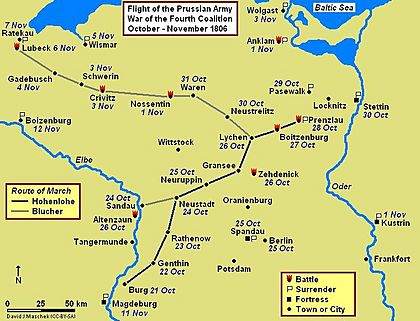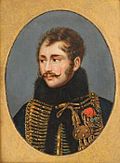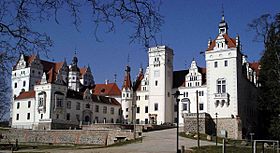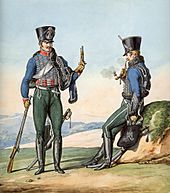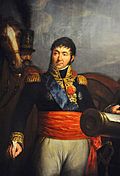Capitulation of Pasewalk facts for kids
Quick facts for kids Capitulation of Pasewalk |
|||||||
|---|---|---|---|---|---|---|---|
| Part of the War of the Fourth Coalition | |||||||
 The Pasewalk Mühlentor, an old city gate |
|||||||
|
|||||||
| Belligerents | |||||||
| Commanders and leaders | |||||||
| Strength | |||||||
| 700-1,500 | 4,200 8 guns |
||||||
| Casualties and losses | |||||||
| None | 4,200 soldiers captured, 8 guns captured, 37 colors captured |
||||||
The Capitulation of Pasewalk happened on October 29, 1806. It was a moment when a large group of Prussian soldiers gave up to a smaller French force. This event was part of the War of the Fourth Coalition.
About 4,200 Prussian soldiers, led by Colonel von Hagen, surrendered to French cavalry brigades. These French brigades were led by Generals Édouard Jean Baptiste Milhaud and Antoine Lasalle. The Prussian soldiers were very tired and discouraged. They had been retreating for two weeks after a big loss at the Battle of Jena-Auerstedt.
Pasewalk is a town in Germany. It is about 110 kilometers north of Berlin. It is also about 40 kilometers west of Szczecin (Stettin) in Poland. Colonel Hagen's group was trying to retreat east towards Stettin. But they got caught between the two French brigades. Without even trying to fight their way out, the Prussian officer surrendered.
This surrender at Pasewalk happened just one day after another similar Prussian surrender. That one was after the Battle of Prenzlau. In the week that followed, two more fortresses gave up without a fight. Many other Prussian groups were also captured.
Contents
What Happened Before the Surrender?
On October 14, 1806, the French army, called the Grande Armée, won a huge victory. Emperor Napoleon I of France led them to defeat the Prussian armies. This happened at the Battle of Jena-Auerstedt.
The Battle of Jena-Auerstedt
At Jena, Napoleon's army of 96,000 soldiers crushed the Prussian army. This Prussian force had 53,000 men. It was led by Generals Frederick Louis, Prince of Hohenlohe-Ingelfingen and Ernst von Rüchel. At the same time, a smaller French group of 26,000 men, led by Marshal Louis-Nicolas Davout, defeated another Prussian army. This army had 49,800 soldiers and was led by Feldmarschall Charles William Ferdinand, Duke of Brunswick.
The French lost about 6,794 soldiers at Jena. The Prussians lost many more, but the exact number is unknown. The Saxons, who fought with the Prussians, lost 59 cannons. The Prussians also lost at least 24 cannons and 12 flags. At Auerstedt, Davout's French troops lost about 7,000 men. Their enemies, the Prussians, lost 10,000 killed or wounded. They also had 3,000 soldiers captured. The Prussians said they lost 57 cannons.
The Prussian army was completely broken after these defeats. Many soldiers were captured or ran away. The Duke of Brunswick, who was badly hurt, died later. General Rüchel was also badly wounded but got better in Poland. The remaining Prussian soldiers formed three main groups. These were led by Prince Hohenlohe, Lieutenant General Gebhard von Blücher, and General Friedrich Adolf, Count von Kalckreuth. They marched towards Halberstadt. Another group of 12,000 men, led by Lieutenant General Karl August, Grand Duke of Saxe-Weimar-Eisenach, was behind them. This group had missed the main battle.
Early Surrenders and Defeats
On October 16, French cavalry led by Marshal Joachim Murat forced a large group of Prussians to surrender. About 12,000 men and 65 cannons gave up at Capitulation of Erfurt. This was the first of many quick Prussian surrenders. The next day, Marshal Jean-Baptiste Bernadotte defeated another Prussian group. This happened at the Battle of Halle. The Prussians lost 5,000 soldiers, while the French lost only 800.
The Long Chase
The Prussian groups led by Hohenlohe and Württemberg met up at Magdeburg on October 20. Kalckreuth's group also joined Hohenlohe's army. He then left for another job in Poland. On October 20, French forces under Soult and Murat arrived at Magdeburg. Murat asked them to surrender, but Hohenlohe refused. That same day, French Marshal Davout captured a bridge over the Elbe River at Wittenberg. Marshal Jean Lannes captured another crossing at Dessau.
King Frederick William III of Prussia ordered Hohenlohe's army to march to the Oder River. So, Hohenlohe's army left Magdeburg on October 21. They reached Burg that night. Hohenlohe left 9,000 men to help defend the city. This meant about 25,000 soldiers were now in Magdeburg. Hohenlohe's army reached Genthin on the night of October 22. They arrived at Rathenow on the evening of October 23. To make it easier to find food, Hohenlohe split his army into several smaller groups.
Napoleon left Marshal Michel Ney's army to start the siege of Magdeburg. He then ordered his right wing to march east towards Berlin. This French right wing included Davout's and Lannes' armies. It also had Augereau's army and four cavalry units led by Murat. The left wing had Bernadotte's and Soult's armies. It also included a dragoon division.
Blücher's Prussian group crossed the Elbe River on October 24. Saxe-Weimar's group crossed two days later. On October 26, Colonel Ludwig Yorck von Wartenburg held off Soult's French advance guard. He then safely crossed to the east bank of the river. At this time, Lieutenant General Johann Friedrich Winning took over from Saxe-Weimar. Hohenlohe marched to Neustadt on October 24. His goal was the fortress of Szczecin (Stettin) on the Oder River. To protect his right side, he told General Christian Ludwig Schimmelpfennig to move through Fehrbellin. Blücher took over as the leader of Hohenlohe's rear guard.
On October 25, Davout's army marched through Berlin. One of Lannes' divisions captured the fortress of Spandau. They took 920 men and 71 cannons. Hohenlohe's main army arrived near Neuruppin that evening. Blücher's rear guard was still at Neustadt. General von Schwerin's cavalry and Colonel von Hagen's infantry were at Wittstock. General Karl Anton von Bila's light brigade reached Kyritz. Napoleon wanted to cut off Hohenlohe's forces. So, he ordered Murat and Lannes to move north from Berlin. French cavalry led by Generals Antoine Lasalle and Edouard Jean Baptiste Milhaud were ready at Oranienburg.
On October 26, Lasalle caught up with Schimmelpfennig at Zehdenick. At first, the Prussians fought well. But when Grouchy's French cavalry attacked, Schimmelpfennig's force broke apart. The survivors ran to Stettin. Lasalle, Grouchy, and Beaumont chased them. This fight made Hohenlohe move further northeast. The next morning, he waited for Blücher and Bila to catch up. Then he continued east. On October 27, Milhaud's French cavalry reached Boitzenburg. They got there before Hohenlohe's advance guard. After a three-hour fight, the Prussians pushed Milhaud's soldiers away. But not before the French took supplies meant for the hungry Prussians at the Schloss Boitzenburg. Murat heard the fighting and marched north with his dragoons. At Wichmannsdorf, French dragoons fought with a Prussian cavalry unit. Murat destroyed the Prussian unit. But Hohenlohe managed to get past him towards Prenzlau.
At 4:00 AM on October 28, Hohenlohe's tired Prussians arrived at Schönermark. This was eight kilometers west of Prenzlau. They decided to continue into Prenzlau. Orders were sent to Hagen to go to Pasewalk. The Battle of Prenzlau happened that day. Murat, with his cavalry and some of Lannes' infantry, stopped Hohenlohe's army. This happened as they marched into the city. Lasalle attacked first, followed by the two dragoon divisions. One of Grouchy's brigades cut through the Prussian column. They captured many prisoners and separated the rear guard. Beaumont's dragoons pushed the rear guard against the Uecker River. This forced Prince Augustus of Prussia to surrender. Hohenlohe still had a clear path to Stettin. But Murat tricked him into surrendering 10,000 soldiers. Murat claimed he was surrounded by 100,000 Frenchmen.
The Surrender at Pasewalk
On October 28, Milhaud's French cavalry moved on Murat's left side. They reached Bandelow, a village between Prenzlau and Pasewalk. From there, he rode towards the sounds of the Battle of Prenzlau. His brigade arrived in time to see Prince Augustus surrender. His soldiers rested that night in Bandelow. The next morning, they rode to Pasewalk. After Hohenlohe surrendered at Prenzlau, Lasalle rode northeast to Löcknitz. This village was on the direct road between Pasewalk and Stettin. Lasalle arrived at 4:00 PM. He placed his cavalry in Löcknitz and Bergholz. They faced northwest, towards Pasewalk.
When Milhaud arrived at Pasewalk, he sent someone to demand a surrender. The Prussian colonel, Hagen, saw Milhaud behind him and Lasalle in front. He immediately gave up. He surrendered with 185 officers and 4,043 soldiers. They also gave up 2,087 cavalry horses, one ammunition wagon, and eight cannons. Hagen's force included his own infantry and Colonel von Podewil's cavalry. The French captured many flags from different Prussian regiments.
The Prussian officers were set free. They promised not to fight against France for the rest of the war. Milhaud's entire force was only 700 cavalrymen. Lasalle's brigade had 800 cavalrymen and two cannons.
Historian Digby Smith wrote that the Pasewalk event showed how low the Prussian army's spirits were. There was no actual fighting. Lannes, a French general, wrote that the Prussian army was so scared that just seeing a Frenchman made them surrender. That same night, Lasalle achieved an even more amazing surrender at Capitulation of Stettin. Between October 30 and November 3, the French captured more Prussian strongholds and supplies. Blücher and Winning decided to head northwest towards Lübeck. The Battle of Lübeck was fought on November 6.




